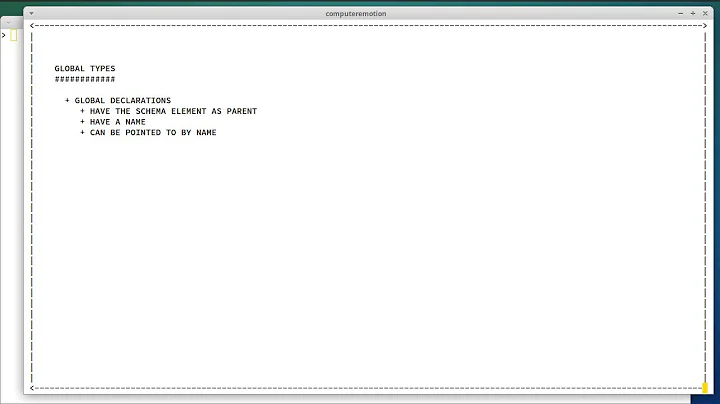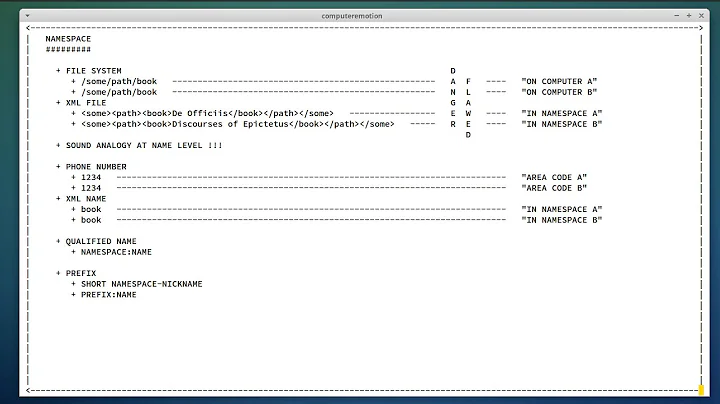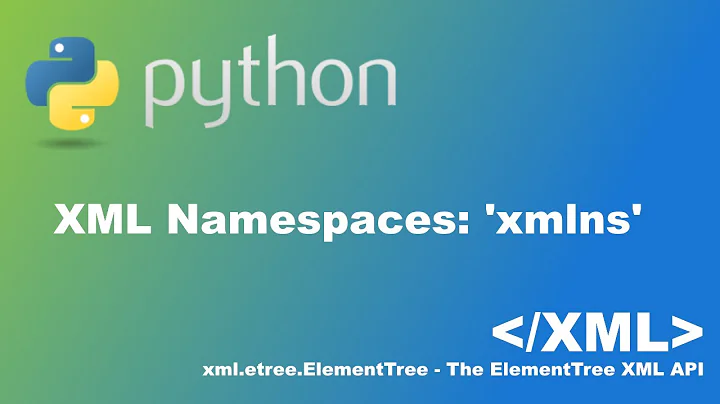XML Schema import -vs- namespaces bound to prefixes
Solution 1
If there's a reference to a component such as vr:someType, then :
you need the namespace declaration so that the processor knows what namespace
vrrefers toyou need the import declaration so the processor knows where to find the component
vr:someType
That's a bit of a simplification. In theory the import doesn't tell the processor where to look; the schemaLocation is only a "hint". In practice for most processors the schemaLocation is either the actual location of a schema document, or a URI that can be redirected (e.g. using a catalog) to the actual location.
The specification could have permitted references such as vr:someType to exist without the import, relying on implementation-defined mechanisms to locate schema components for a particular namespace. But it doesn't permit this.
Solution 2
Well, you need to go to the XML basics to understand all those things...
The real XML name (i.e. that of element or attribute... or some XSD component, like complexType or group) is actually not what you see in a particular XML file (or XML schema). You see something like this:
xs:schema
and you think that's the name of <schema> element. But actually, the real name of that element (with which the XML parser/processor operates) is this:
{http://www.w3.org/2001/XMLSchema}schema
The thing in curly brackets denotes the namespace, which is effective the part of the full name.
Namespaces are needed because, for instance, the <schema> element mentioned here is a part of XSD language provided and maintained by W3C. But suppose, someone else also has some kind of schemas (e.g. the schema of working of some big organization) and wants to describe those schemas with their own <schema> elements. What's more, they may end up having both <schema> elements (i.e. their own and W3C) in the same XML file. How, would an XML parser distinguish them?
Here, the namespaces help. They allow extending local XML names (used in XML) with something else, some extra strings long enough to ensure they are always the same in any XML file on Earth. Those long strings are called namespace URIs and that's what you see in the curly brackets above.
But would you be happy to have your XML file filled with the names like this:
{http://www.w3.org/2001/XMLSchema}schema
You won't be able to read anything there, right?
XML provides a way to work around that problem.
Instead of writing the whole namespace URI along with each XML name, you just need do declare some shortcut for it. That shortcut is called namespace prefix and you declare it with a special binding attribute xmlns:... e.g.:
xmlns:xs="http://www.w3.org/2001/XMLSchema"
Here xs is that prefix (which represents the namespace). Now, you can write everywhere simply:
xs:schema
The namespace prefix itself is a local thing (local to your XML file). You can equally use any other string for this, e.g. 'xsd':
xmlns:xsd="http://www.w3.org/2001/XMLSchema"
and write then
xsd:schema
The root XML element typically contains declarations of all namespace bindings used in the given XML (though, that is not necessary; a binding is valid for a content of the XML element, in which it is declared).
Of course, some XML files (and XSD) may contain namespace bindings never used later. This is not an error. But this is a sort of untidy work (the same as unused variables in a program).
Now, what is the import element for? It just imports some external XML schema into your schema. Importing means that now you can use in your own declarations any global components defined in that imported schema.
But remember that you always work with the full XML names (i.e. local name + namespace URI), because schema processor does so. The imported external schema describes elements (components) in some different namespace. If you want to reference those components, you need to tell the XML processor about their namespace, which you do through some namespace prefix you bind to the imported namespace URI in your XML.
The import element has two attributes:
<xs:import namespace="http://www.ivoa.net/xml/VOResource/v1.0"
schemaLocation="http://www.ivoa.net/xml/VOResource/v1.0"/>
The namespace attribute specifies the namespace URI of what you import. The import element is actually supposed to import only different namespaces (not a part of the one you describe with your schema; for that there is another XSD element: include). So, what you do with the import is called importing of a namespace.
The schemaLocation attribute tells the schema parser the physical location of the imported schema (XSD) file. This is optional attribute. Some XML schema software may hold local copies of the XML schemas describing some important namespaces (particularly those maintained by W3C). So, only namespace URI may be enough to hint where they should take the corresponding XSD file itself.
In short:
What does namespace binding means? It allows you to introduce a short (namespace prefix) for a namespace URI (which is a long string). By adding the namespace prefix to a local name, you tell the XML processor to which namespace that XML name belongs. Here the 'namespace' is an abstract notion. It just extends any XML names to make them absolutely unique. However, the namespace binding does not assume that there are any schemas with any components defined for that namespace!
What does XSD
importelement do? It imports all global components defined in a certain namespace (in a cetain XML schema) and makes them available in your schema. This has nothing to do with bindings of particular prefixes to URIs!
Related videos on Youtube
Marcus Junius Brutus
Updated on October 26, 2022Comments
-
 Marcus Junius Brutus over 1 year
Marcus Junius Brutus over 1 yearI am new to XML Schema and am coming across schema documents that bind a number of prefixes to various namespaces in the
xsd:schemaroot element and also import a subset of such schemas. In the rest of the XML Schema document they happily make use of all prefixes bound in thexsd:schemaelement (whether imported or not).So what does an
importof a namespace signify over 'just' binding that namespace to a prefix?From the Definitive XML Schema book I read (pg. 66):
an import is used to tell the processor that you will be referring to components from other namespaces
In my understanding, that's also what a binding does, so what's the difference?
concrete example
<?xml version="1.0" encoding="UTF-8"?> <xs:schema xmlns:xs="http://www.w3.org/2001/XMLSchema" xmlns:vr="http://www.ivoa.net/xml/VOResource/v1.0" xmlns:ssap="http://www.ivoa.net/xml/SSA/v1.0" xmlns:vm="http://www.ivoa.net/xml/VOMetadata/v0.1" targetNamespace="http://www.ivoa.net/xml/SSA/v1.0" elementFormDefault="unqualified" attributeFormDefault="unqualified" version="1.0pr2"> <xs:import namespace="http://www.ivoa.net/xml/VOResource/v1.0" schemaLocation="http://www.ivoa.net/xml/VOResource/v1.0"/> <!-- ... rest of the schema document follows -->Namespace
http://www.ivoa.net/xml/VOResource/v1.0in the above schema document is both bound to the vr prefix and imported. Other namespaces are only bound to certain prefixes and not imported. The rest of the document uses components from both vr (bound and imported) and ssa (bound but not imported) prefixes. What's the difference? -
 Marcus Junius Brutus almost 11 yearsI get all that. My question was: how is it possible to bind a namespace to a prefix and NOT IMPORT the namespace? In other words, when I see a prefix bound to a namespace, and that prefix is also actually used, shouldn't I also expect to see an import statement for the namespace?
Marcus Junius Brutus almost 11 yearsI get all that. My question was: how is it possible to bind a namespace to a prefix and NOT IMPORT the namespace? In other words, when I see a prefix bound to a namespace, and that prefix is also actually used, shouldn't I also expect to see an import statement for the namespace? -
 Marcus Junius Brutus almost 11 yearsThe thing is, if I see a prefix bound to a given namespace, and that prefix is actually used (it's not a case of an unused prefix), shouldn't I also expect to find an import statement for that namespace? Because, in the industry standards I work with, I see prefixes actually used without their namespaces imported, and yet the toolchain (JAXB in my case) is able to process the schemas. So if I read you right you say that the processor must have gotten the schemas somehow, even without an import?
Marcus Junius Brutus almost 11 yearsThe thing is, if I see a prefix bound to a given namespace, and that prefix is actually used (it's not a case of an unused prefix), shouldn't I also expect to find an import statement for that namespace? Because, in the industry standards I work with, I see prefixes actually used without their namespaces imported, and yet the toolchain (JAXB in my case) is able to process the schemas. So if I read you right you say that the processor must have gotten the schemas somehow, even without an import? -
 Michael Kay almost 11 yearsIn XSD 1.0, the rules were a bit fuzzy. The spec (XSD 1.0 part 1 section 4.2.3) says "Two things are required: not only a means of addressing such foreign components but also a signal to schema-aware processors that a schema document contains such references", and the intent is that you need both a namespace declaration and an xs:import, but this is the only indication that the xs:import is mandatory. XSD 1.1 is much more explicit: "if references to components in a given namespace N appear in a schema document S, then S must contain an <import> element importing N.
Michael Kay almost 11 yearsIn XSD 1.0, the rules were a bit fuzzy. The spec (XSD 1.0 part 1 section 4.2.3) says "Two things are required: not only a means of addressing such foreign components but also a signal to schema-aware processors that a schema document contains such references", and the intent is that you need both a namespace declaration and an xs:import, but this is the only indication that the xs:import is mandatory. XSD 1.1 is much more explicit: "if references to components in a given namespace N appear in a schema document S, then S must contain an <import> element importing N. -
 Michael Kay almost 11 yearsYes, you should expect to see an xs:import for the namespace.
Michael Kay almost 11 yearsYes, you should expect to see an xs:import for the namespace.








